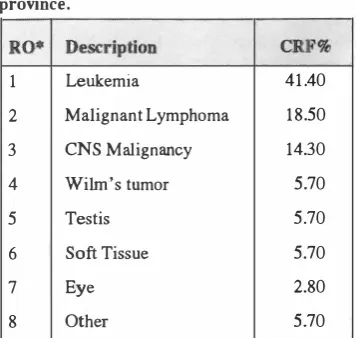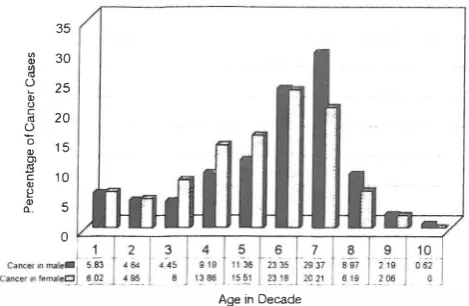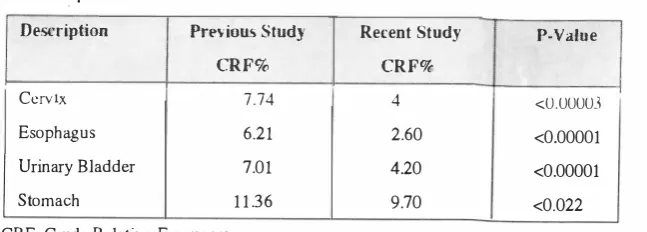Islamic Republic of Iran Spring 1377 May 1998
THE PATTERN OF MALIGNANT TUMORS IN
KERMAN PROVINCE
H. TABRIZCHEE, M.D., M. MASOOMIAN, M.D., F. AHANI, M.D.,
AND M.S. ZARE, M.D.
From the Department of Pathology, Kerman University of Medical Sciences, Kerman, Islamic Republic of Iran.
ABSTRACT
This investigation was done in Kennan from March 1989 to March 1993 to study the epidemiology of cancers in this province and to compare the results with a previous study performed in this area and some available statistics.
A total number of 288 1 new cases of malignancy were registered and the crude relative frequency of cancers was studied. Gastric cancer with a frequency of 9.7%, malignant lymphoma with 8.8% and leukemia with 6.8% were the three most common malignancies in this province, excluding skin malignancy.
Keywords: Cancer epidemiology, Gastric carcinoma, Malignant lymphoma, Breast carcinoma.
MJIRI, Vol. 12, No.1, 19-23, 1998.
INTRODUCTION
Epidemiologic studies have shown that the frequency and distribution of cancer varies enormously between population subgroups around the world which are defined by such variables as race, age, sex, occupation, geographic factors and life style. This epidemiologic study includes all malignant tumors of Kerman province registered during a four year period from March 1989 to March 1993.
A previous epidemiologic study of malignant tumors was also done in this region during a nine year period from March 1980 to March 1989. Some available statistics from other areas of Iran and other countries are compared and discussed in this article.
MATERIAL AND METHODS
The data used in this retrospective epidemiologic study
Address for correspondence:
H. Tabrizchee, M.D., Esteghlal Street, Tabrizchee Alley, No. 44, Kennan, LR. Iran.
was collected from pathology records registered in pathology laboratories in Kerman province from March 1989 to March 1993. The laboratories included two pathology centers of Kerman Medical School, one private pathology laboratory in Kerman and one university pathology center in Rafsanjan. No other pathology center was functional during the period of this study in this province. There is a possibility that a few cases « 1 %) from the neighboring provinces (Sistan, Hormozgan, Fars and Yazd) may have been included in our samples.
During this four year period, a total number of 37,366 pathologic samples were referred to these diagnostic centers in this region, of which 2881 new cases of malignancy were diagnosed. The samples were examined histologically or by the study of blood and bone marrow smears. All cases were studied and diagnosed by conventional morphologic methods. Clinical information such as sex, age and site of sampling were recorded. Cases with repeated biopsy and those which were diagnosed by cytology alone were excluded. All hematologic samples without bone marrow confrrmation were also excluded.
Table I: Crude relative frequency and rank order of most common cancers in Kerman province.
Both Sexes Both Sexes Males Males Females Females
RO· Description CRF% Description CRF% Description CRF%
Skin 19.10 Skin 20.71 Skin 17.08
2 Stomach 9.70 Stomach 12.20 Breast 12.70
3 Malignant Lymphoma 8.80 Malignant Lymphoma 9.70 Malignant Lymphoma 7.50
4 Leukemia 6.80 Leukemia
5 Breast 5.70 Bladder
6 Colorectal 4.70 Colorectal
7 Bladder 4.20 Lung
8 CNS 3.70 CNS
9 Liver 3.20 Prostate
10 Lung 2.90 Larynx
11 Esophagus 2.60 Liver
12 Larynx 2.40 Bone
13 Bone 2.30 Esophagus
14 Prostate 2.10 Testis
15 Cervix 1.70 Oral cavity
16 Endometrium 1.60 Small Intestine
17 Thyroid 1.50 Soft tissue
18 Soft tissue 1.50 Kidney
19 Gallbladder 1.30 Eye
20 Oral cavity 1.20 Gallbladder
*RO: Rank Order. CRF: Crude Relative Frequency.
RESULTS
Examination of 37,366 pathological samples resulted in the diagnosis of 2881 new cases of malignancy in Kerman province during a four year study (March 1989-March 1993). Therefore, 7.71 % of the reported cases were positive for malignancy . The male:female ratio for malignant tumors was 1.35: 1. Significantly high male: female ratios in non-sex organs were found in cancers of salivary glands (11: 1), larynx (5.5: 1),lung(4.9: 1), adenocarcinoma of the esophagus (4.2: 1), carcinoma of the urinary bladder (2. 93: 1), carcinoma of the pancreas (2. 66) and the stomach (2.57: 1).
Cancer of the thyroid (male: female ratio, 0.21: 1) and gallbladder (0.37: 1) exhibited female preponderance.
Maximum age frequency of cancer for males and females were in the seventh and sixth decades of life, respectively (Fig. 1).
7.00 Leukemia 6.70
5.50 Stomach 6.30
4.30 Colorectal 5.30
4.20 Cervix 4.00
3.90 Endometrium 3.70
3.80 CNS 3.40
3.70 Thyroid 3.00
3.50 Liver 2.80
2.90 Bladder 2.50
2.70 Esophagus 2.40
1.40 Gallbladder 2.30
1.10 Ovary 2.20
1.00 Soft tissue 2.10
1.00 Bone 1.60
0.90 Oral cavity 1.20
0.80 Eye 1.20
0.60 Lung 1.10
Table II: Crude relative frequency and rank order of most common cancers in the pediatric age group (below 5 years old) in Kerman province.
RO* Description CRF%
1 Leukemia 41.40
2 Malignant Lymphoma 18.50
3 CNS Malignancy 14.30
4 Wilm's tumor 5.70
5 Testis 5.70
6 Soft Tissue 5.70
7 Eye 2.80
8 Other 5.70
*RO: Rank Order. CRF: Crude Relative Frequency.
'" Ql :1l 0 ij; " c os 0 0 Ql Cl g c Ql £! Ql "'-35 30 25 20 15 10 5 0
Age in Decade
Overall, carcinoma was about five times more common than sarcoma in both sexes. The most common type of carcinoma was gastric adenocarcinoma (11.6%) and the most common type of sarcoma was malignant lymphoma (8.8%). The crude relative frequency (CRF) of the twenty most common cancers are given in Table I.
In males, the first two outstanding cancers were of the stomach (12.2%) and malignant lymphoma (9.7%) if skin cancer (20.7%) was excluded, but in females, breast cancer (12.7%) and malignant lymphoma (7.5%) ranked as the first and second most common types of cancer after skin cancer (17.08%).
Fig. 1. Age and sex distribution of cancer in Kerman province.
In skin cancer, which ranked first in both sexes, basal cell carcinoma (67.5%) was the most common type, followed by squamous cell carcinoma (23.9%) and malignant melanoma (3.9%).
Table III: Crude relative frequency and rank order of most common cancers in the pediatric age group (below 15 years old) in Kerman province.
RO· Description CRF%
1 Leukemla 41.50
2 Malignant Lymphoma 21.00
3 CNS Mahgnancy 14.50
4 Bone 5.00
5 Soft Tissue 4.00
6 Wilm 's tumor 2.50
7 Testis 2.50
8 Skin 2.50
9 Other 13.00
*RO: Rank Order. CRF: Crude Relative Frequency.
In this study, a total num ber of 200 cases of malignancy (6.9%) belonged to the pediatric age group (below 15 years old). The three most common malignant tumors in this group were leukemia (41.4%), malignant lymphoma (18.5%) and central nervous system tumors (14.3%) (Tables II and III).
DISCUSSION
The main aim of this work was to compare the results of this epidemiologic study with a previous one in Kerman province and some available cancer statistics from other areas. Many types of cancer showed almost the same crude relative frequency (CRF) in this study and the previous one, though other forms showed a higher or lower frequency. The most significant increase in frequency was related to CNS malignancy, liver, endometrium and lung cancers. An
obvious decrease in frequency of malignancy is seen in cancers of the esophagus, urinary bladder, stomach and uterine cervix. Table IV and V compare the differences between the results of recent and previous studies.
For some differences we have a logical explanation
. Table IV: The most common cancers with a higher frequency in our recent study
in Kerman province.
Description Previous Study
CRF%
CNS Malignancy
Liver
Endometrium
Lung
CRF: Crude Relative Frequency P-Value < 0.05.
<1
1
2.65
2.08
Recent Study P-Value
CRF%
3.70 <0.00001
3.20 <0.00001
3.70 <0.039
2.90 <0.006
Table V: The most common cancers with a lower frequency in Our recent study in Kerman province.
Description Previous Stud}'
CRF%
Cervix
Esophagus
Urinary Bladder
Stomach
CRF: Crude RelatIve Frequency P-Value < 0.05.
7.74
6.21
7.01
11.36
while for the others we have no justifications yet. As shown in Table IV, CNS malignancy shows a marked difference of frequency in the two studies. T�e most probable reason for this difference could be the establishment of a neurosurgery department in this area in 1988, which has provided samples to the pathology laboratories since that time, whereas neurosurgical samples were rare in the previous study.
Advances in diagnostic methods to detect liver malignancy in this region can explain the higher frequency of liver cancer in this study. Such diagnostic methods include ultrasonography, CT scanning, MRI and aspiration needle biopsy of the Ii ver which were not regularly available in the previous study. For endometrial adenocarcinoma which shows a 1 % increase in frequency as compared with the previous study, we have no definite explanation.
The increase in frequency of lung cancer may also be due to the advances in diagnostic methods, mainly endoscopic and radiologic facilities. No reasonable explanation for the lower frequency of urinary bladder, esophageal and gastric cancer in this study can be provided at the present time.
The decrease in frequency of uterine cervix carcinoma can be due to the extensive practice of vaginal smears as a routine test for many adult females. Some cancers (salivary gland, larynx, lung and urinary bladder) show a significant male: female preponderance. Whether that is due to a higher rate of smoking habits in males or some other occupational and habitual factor remains to be answered in further studies.
When the statistics of common cancers in this region are compared with the available data from other countries (mainly from the American Cancer Society [A.C.S.] reports)2, some major differences could be found. Gastric carcinoma which is the most common cancer in this region with a CRF of 9. 7 % shows a high frequency in China, Japan and Russia, but is not a common type of cancer in the U.S.A.2 A survey among Japanese emigrants to the U.S.A. shows a major role for environmental and cultural influences.3 Whether such factors are applicable in this
Recent Study P-Value
CRF%
4 <U.UUUU3
2.60 <0.00001
4.20 <0.00001
9.70 <0.022
region or not needs further investigation.
The frequenc y of malignant lymphoma ( 8. 8%; confidence interval [C.I.] 95%= 7.8-9.8%) and leukemia (6.8%; c.l. 95%= 5.9-7%) in this study seems fairly high compared to the previous study (7% and 6.2 %, respectively). According to other studies the CRF for malignant lymphoma is 7.63 to 8.4%4 in Iran, 11.7% in Lebanon,6 13.5% in Iraq,? 10.3% in Saudi Arabia8 and 4.7% in the U.S.A.2
Breast carcinoma with aCRF of 12.7% eCI [95%]= 2.9-4.7%) is the most common malignancy in females in this region, excluding skin cancer. The frequency of breast cancer in American women is about 31 %2, while in China this is not a common malignancy.3 Most probably some cultural differences such as age of marriage, number of pregnancies and habit of breast feeding can account for such differences, although other risk factors such as hereditary factors may also influence the frequency of breast cancer. The other major difference in frequency belongs to prostatic carcinoma which shows almost a low frequency in this area and the Middle East with a CRF of 3.8% eCI [95%]= 10.9-14.3%) and 3.3%6, respectively, compared to the high frequency in American males (36%).2 Possible explanations for such differences are as follows: a- Prostatic carcinoma has a geographic distribution throughout the world. It is a common malignancy in the western countries while it has a lower frequency in eastern countries such as Japan.3
b- Prostate cancer is a malignancy of older men, usually over fifty years of age, which are a relatively minor age group in the general popUlation of this country.
c- Prostatic carcinoma in our study was diagnosed on prostatectomy specimens of patients with a clinical diagnosis of benign prostatic hyperplasia and suspected cases of prostatic carcinoma according to digital rectal examinations. Such methods of detection cannot detect those cases of prostatic carcinoma which are detected in developed countries by studying serum prostatic-specific antigen (PSA) and transrectal sonography and needle biopsy. The other major difference between our results and
American statistics pertains to lung cancer. The CRF of lung cancer in this study was 4.2% (CI [95%]= 2.9-4.7%) in males and 1. 1 % in females, whereas in American studies this was 14% and 13%, respectively.2 Except for some differences in diagnostic methods, we have no other explanation for such a difference.
Colorectal carcinoma in Americans also shows a high frequency with a CRF of 10% and 12% in males and females, respectively.2 In our study the CRF for colorectal carcinoma was 4.3% (CI [95%]= 3.5-5.3%) and 5.3% (CI [95%]= 4. 1-6.3%), while in the Middle East these figures were 5.6% in males and 4.3 % in females.6 Such a difference can be explained by environmental or mainly dietary differences.3
ACKNOWLEDGEMENT
We would like to thank the research deputy of the Kerman University of Medical Sciences for his support in this project.
REFERENCES
1. Gupta RK, Tabrizchee H: Pattern of malignant tumors in Kerman province. Med J Islam Rep Iran 5: 91, 1991.
2. American Cancer Society: Cancer statistics, Vol. 45, No.1, 1995.
3. Cotran R, Kumar V, Robbins S: Pathologic Basis of Disease. 5 th edition, Philadelphia: W.B. Saunders Co, pp. 241-303, 1994.
4. Haghighi P, Nabizadeh I, Asvadi S, Mahallatee EA: Cancer in southern Iran. Cancer 27: 965-977, 1971.
5. Habibi A: Cancer in Iran, a survey of most common cases. J National Cancer Inst 34: 533-569, 1965.
6. Azar HA: Cancer in Lebanon and the Near East. Cancer 15:
66-78, 1962.
7. Majeed AMA: Cancer in Nineva province. Ann Coli Med
Mosul (Iraq) 13: 9-19, 1982.
8. El Akkad SM, et al: Pattern of cancer in Saudi Arabia, referred to King Faisal Specialist Hospital. Cancer 58: 1172-8, 1986.


